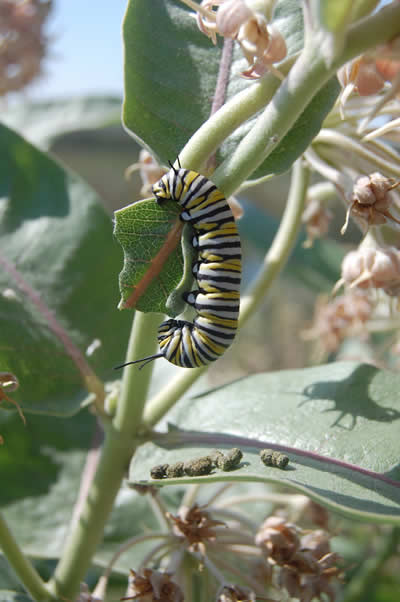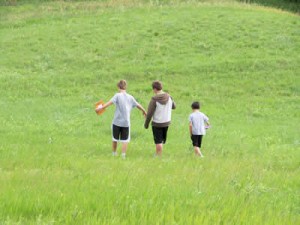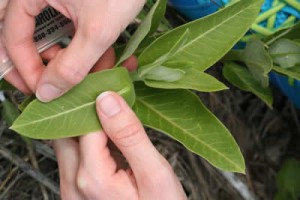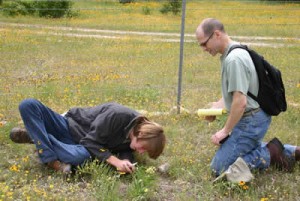
Monarch larva on milkweed plant. Photo credit: Becky Hansis-O’Neill.

Monarch larva on milkweed plant. Photo credit: Becky Hansis-O’Neill.
With its familiar pattern of orange and black, the monarch is perhaps the best known butterfly in North America. Each year, adult monarchs migrate from winter roosts to summer grounds across North America.
Along the way, female butterflies lay eggs on milkweed; the eggs then hatch into caterpillars, also known as larvae. The larvae grow by feeding on milkweed; through metamorphosis, they transform into the next generation of adult butterflies and continue their annual journey across thousands of miles. In the fall, the newest generation of adults flies south to the overwintering sites.
But now the monarch is in trouble. Due to habitat loss, patches of milkweed are fewer and farther between, so the number of monarch larvae is dwindling.
In the 1990s, researchers at the University of Minnesota decided to use citizen science to collect long-term data on monarch larvae and milkweed habitat in order to provide information that decisionmakers can use to help prevent the monarch’s decline. The Monarch Larva Monitoring Project has grown to involve volunteers from across Canada and the United States.
Download this case study (PDF, 131KB)
Website: Monarch Larva Monitoring Project

Children walking sampling transect during MLMP monitoring. Photo credit: Laura Molenaar.
Participants in the program volunteer to monitor a particular site — often their own backyards — following a standard protocol. Through online or in-person training, the volunteers learn how to identify milkweed as well as the eggs, caterpillars and pupae of monarch butterflies. They also learn about the monarch’s annual cycle of breeding, migrating and overwintering.
Each year, volunteers record when milkweed plants first come out of the ground and how many are present at the site they are monitoring. Then, on a weekly basis, they record the number of eggs and caterpillars they see on the milkweed. They also have the option of collecting other useful data, such as the amount of rainfall or the relationship between a parasite and host.
The final step in the monitoring process is logging on to a secure website and entering the data collected into a master database.

Monarch egg on milkweed plant. Photo credit: Wendy Caldwell.
For citizen science projects, data validity can be a concern. Some say that non-scientists can’t be trusted to collect reliable data. The project addresses such concerns by using a standardized protocol and requiring repeated observations of the same species in the same place over time. The MLMP also offers in-person and online training, and all data are carefully checked before they are used for research purposes.
Another challenge is getting volunteers to report zeroes, or the lack of monarchs. As the monarch population declines, fewer and fewer monarchs are found during monitoring; this can discourage volunteers and cause them to not want to collect or submit data. MLMP staff work with volunteers to highlight the importance of knowing where monarchs are not found, as well as where they are present.
The project is successfully meeting its core purpose: to help scientists better understand how and why monarch populations are changing. As of 2015, project participants had monitored almost 1,100 sites in 43 states and three Canadian provinces, along with the Mexican state of Jalisco. Data provided by citizen scientists have allowed the scientific community to track the health of monarch populations and the habitats they depend on, forming the basis for a growing number of scientific publications.

Volunteers monitoring for MLMP. Photo credit: Kip Kiphart.
The Monarch Larva Monitoring Project case study illustrates the following steps in the Federal Citizen Science and Crowdsourcing Toolkit:
Karen Oberhauser
Email: info@mlmp.org
Wendy Caldwell
Email: info@monarchjointventure.org